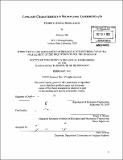| dc.contributor.advisor | Roger D. Kamm. | en_US |
| dc.contributor.author | Das, Anusuya | en_US |
| dc.contributor.other | Massachusetts Institute of Technology. Dept. of Biological Engineering. | en_US |
| dc.date.accessioned | 2011-05-09T15:25:11Z | |
| dc.date.available | 2011-05-09T15:25:11Z | |
| dc.date.copyright | 2010 | en_US |
| dc.date.issued | 2011 | en_US |
| dc.identifier.uri | http://hdl.handle.net/1721.1/62720 | |
| dc.description | Thesis (Ph. D.)--Massachusetts Institute of Technology, Dept. of Biological Engineering, February 2011. | en_US |
| dc.description | Cataloged from PDF version of thesis. | en_US |
| dc.description | Includes bibliographical references (p. 119-128). | en_US |
| dc.description.abstract | Angiogenesis is crucial during many physiological processes, and is influenced by various biochemical and biomechanical factors. Models have proven useful in understanding the mechanisms of angiogenesis and the characteristics of the capillaries formed as part of the process. We have developed a 3D hybrid, agent-field model where individual cells are modeled as sprout-forming agents in a matrix field. Cell independence, cell-cell communication and stochastic cell response are integral parts of the model. The model simulations incorporate probabilities of an individual cell to transition into one of four states - quiescence, proliferation, migration and apoptosis. We demonstrate that several features such as continuous sprouts, cell clustering and branching that are observed in microfluidic experiments conducted under controlled conditions using few angiogenic factors can be reproduced by this model. We also identify the transition probabilities that result in specific sprout characteristics such as the length and number of continuous sprouts. We have used microfluidics to study cell migration and capillary morphogenesis. The experiments were conducted under different concentrations of VEGF and Ang I. We demonstrated that capillaries with distinct characteristics can be grown under different media conditions and that characteristics can be altered by changing these conditions. A two-channel microfluidic device fabricated in PDMS was used for all experiments. The rationale underlying the design of the experiments was twofold: the first goal was to generate reproducible and physiologically relevant results in a microfluidic device, and the second goal was to quantify the capillary characteristics and use them to estimate the transition parameters of the model. We developed stable, well-maintained sprouts by using human microvascular endothelial cells in 2.5 mg/ml dense collagen I gel and by using media supplemented with 40 ng/ml VEGF and 500 ng/ml Ang 1 for two days. It has been shown in many studies that VEGF acts as an angiogenic factor and Ang 1 acts as stabilizing factor. Here we showed that their roles are maintained in the 3D microenvironment, and the sprout characteristics obtained by using this baseline condition could be altered by changing the concentrations of these two growth factors in a systematic way. Sprout and cell characteristics obtained in the experiments and simulations were analyzed by adapting Decision Tree Analysis. This methodology provides us with a useful tool for discerning the impact of different growth factors on the process of cell migration or proliferation as they alter general sprout morphology. The imprints obtained via experiments and simulations were compared; by choosing appropriate values of the transition probabilities, the model generates capillary characteristics similar to those seen in experiments (R2 ~ 0.82- 0.99). Thus, this model can be used to cluster sprout morphology as a function of various influencing factors and, within bounds, predict if a certain growth factor will affect migration or proliferation as it impacts sprout morphology. This was demonstrated in the case of anti-angiogenic agent, PF4. We showed that at high concentration of PF4 (- 1000 ng/ ml), the transition to migration is more profoundly affected while at low concentrations of - 10 ng/ ml, PF4 does not have much of an effect on either migration or proliferation. | en_US |
| dc.description.statementofresponsibility | by Anusuya Das. | en_US |
| dc.format.extent | 142 p. | en_US |
| dc.language.iso | eng | en_US |
| dc.publisher | Massachusetts Institute of Technology | en_US |
| dc.rights | MIT theses are protected by copyright. They may be viewed, downloaded, or printed from this source but further reproduction or distribution in any format is prohibited without written permission. | en_US |
| dc.rights.uri | http://dspace.mit.edu/handle/1721.1/7582 | en_US |
| dc.subject | Biological Engineering. | en_US |
| dc.title | Capillary characteristics in microfluidic experiments and computational simulation | en_US |
| dc.type | Thesis | en_US |
| dc.description.degree | Ph.D. | en_US |
| dc.contributor.department | Massachusetts Institute of Technology. Department of Biological Engineering | |
| dc.identifier.oclc | 715421370 | en_US |
